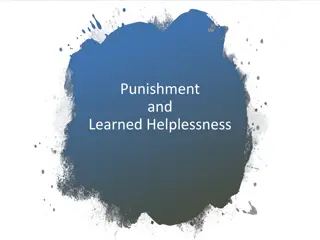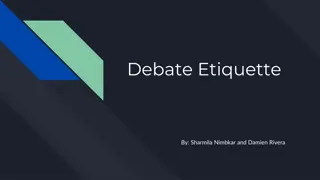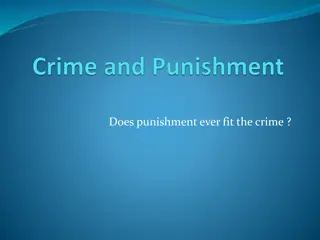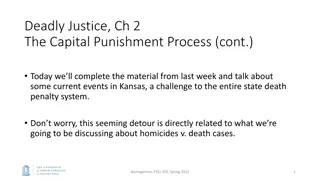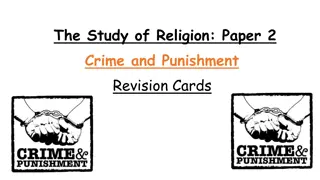Debate on Capital Punishment: Perspectives and Controversies
Explore the debate surrounding capital punishment, also known as the death penalty. Discover arguments for and against this practice, considerations of human rights, and a look at countries that still allow capital punishment. Reflect on the ethical implications and the value of human life in the context of justice systems worldwide.
Download Presentation

Please find below an Image/Link to download the presentation.
The content on the website is provided AS IS for your information and personal use only. It may not be sold, licensed, or shared on other websites without obtaining consent from the author.If you encounter any issues during the download, it is possible that the publisher has removed the file from their server.
You are allowed to download the files provided on this website for personal or commercial use, subject to the condition that they are used lawfully. All files are the property of their respective owners.
The content on the website is provided AS IS for your information and personal use only. It may not be sold, licensed, or shared on other websites without obtaining consent from the author.
E N D
Presentation Transcript
Finnis Natural Law and Hooses Proportionalism: Application to Capital Punishment Capital Punishment
Starter Finnis Natural Law and Hoose s proportionalism would justify capital punishment in the case of murder. DISAGREE AGREE
What is Capital Punishment? Capital punishment, also known as the death penalty, is a government sanctioned practice whereby a person is put to death as a punishment for a crime they have committed . The sentence that someone is punished in this way is referred to as a death sentence, whereas the act of carrying out the sentence is known as an execution. Crimes that are punishable by death are known as capital crimes or capital offences, and they commonly include offences such as murder, treason, espionage, war crimes, crimes against humanity and genocide.
What countries still allow Capital Punishment? Here are ten examples of places that still allow the death penalty: 1. Pakistan 2. Jamaica 3. Japan 4. Barbados 5. Egypt 6. India 7. Syria 8. Taiwan 9. Cuba 10. United States
Total Executions in 2015 According to Amnesty International, 25 countries carried out at least 1,630 executions last year. Nineteen Asian countries: Afghanistan (1), Bangladesh (4), China (exact number unknown), India (1), Indonesia (14), Iran (977+), Iraq (26+), Japan (3), Jordan (2), Malaysia (exact number unknown), North Korea (exact number unknown), Oman (2), Pakistan (326), Saudi Arabia (158+), Singapore (4), Taiwan (6), UAE (1), Vietnam (exact number unknown), and Yemen (8+). Five African countries: Chad (10), Egypt (22+), Somalia (25+), South Sudan (5+), Sudan (3). One American country: United States (28).
Arguments against capital punishment Value of human life Everyone thinks human life is valuable. Some of those against capital punishment believe that human life is so valuable that even the worst murderers should not be deprived of the value of their lives. Right to live Everyone has an inalienable human right to life, even those who commit murder; sentencing a person to death and executing them violates that right. Execution of the innocent The most common argument against capital punishment is that sooner or later, innocent people will get killed, because of mistakes or flaws in the justice system.
Arguments against continued... Arguments against continued... Failure to deter The death penalty doesn't seem to deter people from committing serious violent crimes. The thing that deters is the likelihood of being caught and punished. Brutalising society Statistics show that the death penalty leads to a brutalisation of society and an increase in murder rate. In the USA, more murders take place in states where capital punishment is allowed. In 2010, the murder rate in states where the death penalty has been abolished was 4.01 per cent per 100,000 people. In states where the death penalty is used, the figure was 5.00 per cent. These calculations are based on figures from the FBI. The gap between death penalty states and non-death penalty states rose considerably from 4 per cent difference in 1990 to 25 per cent in 2010.
Arguments in favour of capital punishment Deterrence Capital punishment is often justified with the argument that by executing convicted murderers, we will deter would-be murderers from killing people. Prevention of re-offending It is undeniable that those who are executed cannot commit further crimes. There have been cases of persons escaping from prison and killing again, these are extremely rare. Closure and vindication It is often argued that the death penalty provides closure for victims' families.
Progress Check: Be able to... Understand the main issues related to capital punishment. Apply Finnis Natural Law and Hoose Proportionalism can be applied to capital punishment. Explain how Finnis Natural Law and Hoose Proportionalism can be applied to capital punishment.
Task: Working in pairs, prepare to give your judgements on the approach of John Finnis natural law and Hoose s proportionalism to capital punishment. Complete the worksheet.
Conclusions: Finnis Natural Law Finnis disagrees with capital punishment. When using practical reason we must show respect for every basic good in every act. Acting against an basic good is wrong in every situation. He totally disagrees with consequentialism which is the theory that it is legitimate (or even required) to bring about evil if doing so one can bring about the greater good. Therefore capital punishment is wrong.
Conclusions: Proportionalism Any form of punishment is a non-moral evil (or pre-moral evil) in so much as it inflicts pain on another person. However, if it is the most effective way of reducing crime, capital punishment can be justified. However, Hoose accepts that studies have shown that the removal of capital punishment as a form of punishment in a country (or state) has not led to an increase in homicides. In fact some scholars have actually suggested it runs the risk or brutalising the general population.
Progress Check: What do you think now? Finnis Natural Law and Hoose s proportionalism would justify capital punishment in the case of murder. DISAGREE AGREE
Lesson Objectives: Be able to... Understand the main issues related to capital punishment. Apply Finnis Natural Law and Hoose Proportionalism can be applied to capital punishment. Explain how Finnis Natural Law and Hoose Proportionalism can be applied to capital punishment.
Consolidation: Exam Question Explain how Finnis natural law and Hoose s proportionalism can be applied to capital punishment. Things to consider: Main points Introduce Finnis natural law and apply to capital punishment. Introduce Hoose s proportionalism and apply to capital punishment. Conclusion summarise how they can be applied.
Examiners will be looking for: Candidates need to apply the theory they have learnt in sections 2D and 2E to both ethical issues of immigration and capital punishment. A detailed overview of how the various aspects of Finnis Natural Law (with reference to the appropriate elements of the seven basic human goods, the nine requirements of practical reason and the common good) and Hoose s Proportionalism (only breaking a principle if there is a proportionate reason and based on agape love) apply to these two ethical issues is needed. Candidates should focus on the application of the theory to the issues and not on a broad and detailed description of the ethical issues themselves.
Lesson Objectives: Be able to... Understand the main issues related to capital punishment. Apply Finnis Natural Law and Hoose Proportionalism can be applied to capital punishment. Explain how Finnis Natural Law and Hoose Proportionalism can be applied to capital punishment.
Homework: Read the article on John Finnis developments to natural law and Hoose s Proportionalsim from the following website. http://onlinelibrary.wiley.com/doi/10.1111/j.1741- 2005.2002.tb01821.x/pdf http://cdn.theologicalstudies.net/60/60.2/60.2.7.pdf






